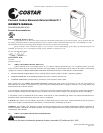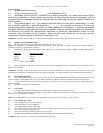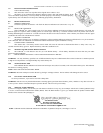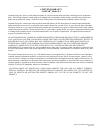
Instruction Manual: COSTAR® P-1, 9V Personal CO Detector
If alarm sounds:
2.1 Operate reset/silence button;
2.2 Call your emergency services (____ - _____) [fire department or 911];
2.3 Immediately move to fresh air – outdoors or by an open door/window. Do a head count to check that all
persons are accounted for. Do not reenter the premises nor move away from the open door/window until the
emergency services responders have arrived, the premises have been aired out, and your detector remains in its
normal condition.
2.4 After following steps 2.1-2.3, if your detector reactivates within a 24 hour period, repeat steps 2.1-2.3 and
call a qualified automobile or appliance technician (_____-______) to investigate for sources of CO from fuel
burning equipment and appliances, and inspect for proper operation of this equipment. If problems are identified
during this inspection have the equipment serviced immediately. Note any combustion equipment not inspected by
the technician and consult the manufacturers’ instructions or contact the manufacturers directly for more
information about CO safety and this equipment. Make sure that motor vehicles are not and have not been
operating in an attached garage or adjacent to the residence or RV.
WARNING: DO NOT remove the battery to silence the detector because you will not know when to re-enter your vehicle.
3.0 IMPORTANT CONSIDERATIONS
3.1 The COSTAR
®
P-1 has been designed and is warranted to operate for 5 years.
NOTE: The manufacturer recommends replacement of the detector 5 years after date of purchase. Under no circumstances should the
product be used after 7 years from date of purchase.
3.2 The detector is designed to warn individuals before a blood level of 10% carboxyhemoglobin (COHB) is reached (mild exposure).
CO Levels
Max. Response Time
30 ppm None
70 ppm 240 min
150 ppm 50 min
400 ppm 15 min
ppm = parts per million
3.3 When the detector sounds, do not stand too close to the detector. Prolonged exposure to the detector at a close distance may be
harmful to your hearing.
WARNING: Activation of this device indicates the presence of carbon monoxide (CO), which can injure or even kill you. The sound
produced by the detector is not designed to awaken a person in an emergency; it is designed to alert a driver without distracting the driver.
4.0 RECOMMENDATIONS
4.1 It is recommended to test the unit once every week. To test unit, push and hold detector Indicator/Test button until unit beeps
(about 3 seconds). Detector will sound two cycles to indicate completion of the test. The detector will then resume normal operation.
4.2 CO may be from an outside source or from your vehicle. If you suspect your vehicle as the source, have the vehicle inspected by a
qualified mechanic.
4.2.1 DO NOT cover detector ventilation holes.
5.0 LOCATION
One of the most important considerations in any CO detector system is the location of the detector.
5.1 It is recommended to place the unit on the visor of the vehicle. Placement of the detector in a garage may cause the unit to go into
alarm due to CO from automotive exhaust.
NOTE: The COSTAR
®
P-1 may also be used for personal protection from CO in the work place or while traveling.
6.0 LOCATIONS TO AVOID
6.1 Avoid prolonged exposure to direct sunlight.
6.2 Do not keep detector on your dashboard.
6.3 Avoid unit coming into contact with water.
6.4 Do not locate detector near an open window because unit will not detect accurate levels of CO in your automobile.
6.5 Do not use as a garage or home detector.
6.6 Do not use in closed compartments such as glove box or purse.
6.7 DO NOT PLACE DIRECTLY BEHIND A TAILPIPE OR IN THE PATH OF HOT EXHAUST!
WARNING: The COSTAR
®
P-1 CO Detector is not designed for marine use.
QGI P/N 099-0062-01 REV 07/25/01
Page 2 of 4






